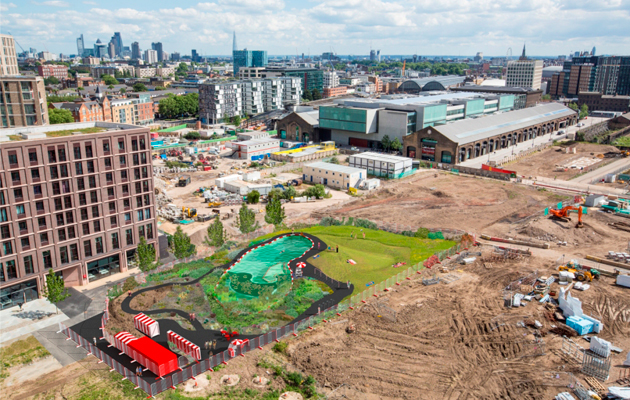|
|
||
|
A German-Dutch team of designers is temporarily transforming part of a vast building site in central London with an intervention that is both a public pool and an art installation For most Londoners, or at least those of a creative bent, the developments around King’s Cross come to an abrupt halt with the huge granary containing Central Saint Martins. Yet, heading north along its western flank, one encounters the diminutive beginnings of the “Lewis Cubitt Park”. Around this, a wide arc of mixed-use buildings is currently under construction. For the next two years, amid this churned earth of building sites, a 40m x 10m, kidney-shaped swimming pool will nestle. Raised above its surroundings, Of Soil and Water: King’s Cross Pond Club, is the fourth and last iteration of the three-year Relay public-art programme, and is due to open next month as a temporary swimming venue, operating with a strict daily limit of 163 bathers. Designed by Rotterdam-based Ooze Architects (Eva Pfannes and Sulvain Hartenberg), along with Berlin-based artist Marjetica Potrč (also originally an architect), it is the first UK example of a closed-loop public pool. This chemical-free approach is now common in Germany and Austria, usually in private spas or homes. Pools are divided between a swimming zone and regeneration and filtration zones, which incorporate underwater and floating plants to oxygenate and cleanse the water. The ratio between the volume of water and the quantity of filters and plants in the pool produces an inflexible ceiling on the number of users, ensuring that the King’s Cross project teeters between leisure and art – Hartenberg admits that “163 is an OK number – it’s not as many as we wanted, but we couldn’t just expand the pool”. The trio first collaborated in 2009 on a similar act of place-making at the behest of Amsterdam’s Stedelijk, and a number of joint projects have ensued, often combining overlooked habitats and sustainable water usage to create awareness of common land. For instance, at 2010’s Between the Waters in Essen, a complete water system – from toilet to fresh water – was demonstrated in fearless fashion along the banks of the Emscher river. As Hartenberg recalls: “It was our first exercise in place-making – it was a no-man’s-land, but you had a bicycle path, and people started to use this place, to stop, to go to the toilet, to have a drink – it created this thing, this sense of community.” The initial brief at King’s Cross, according to Pfannes, was to just “do something”. As Hartenberg says: “We were given seven sites so made five different proposals – practising in this way gives us a good opportunity to think right from the source and decide what would be the best idea for any particular place.” The use of water was not obligatory, but the proximity and history of Regent’s Canal made it an attractive proposition, while, for Hartenberg, “the idea of opening this pocket of something totally ‘other’ within a building site was particularly exciting”. Pfannes explains: “Building sites are places where a city is in the making – when you visit them, you always see people standing there just looking. And there are always plots on those sites that are sleeping more than others, so to temporarily use one of them to make a project like this, particularly given their land value, opens unusual new possibilities.” One of these possibilities is being explored in the planting around the site. Eighty seasonal wild species will be planted, many of which formerly grew in cities but have been driven out by over-development. Their progress will be monitored to see which have the capacity to flourish once more, with the assistance of local youngsters as part of the Global Generation community gardening project. The resulting juxtaposition of artwork and nature with the life of a building site – a swamp of mud, cranes and high-vis jackets – gives Of Soil and Water, with its serene air and colourful changing rooms, a certain surreality. It is intended as a place to stop and reflect as well as swim, and part of the appeal, as Pfannes says, is that “normally you go super-protected into building sites, but here you strip off all your protective layers right in the middle of the city”. The act of swimming brings about an enhanced sensitivity to surroundings and seasons. |
Words John Jervis
RSVP TO ATTEND OOZE’S TALK AT ICON’S HOUSE OF CULTURE AT 1pm ON 19 MAY |
|
|
||
|
|
||
|
Practical challenges compromised the ambition of working in balance with nature. According to Hartenberg, “In the beginning we thought, ah, we’re working on a building site, it’s easy, it’s just a lump of earth. But the reality is far more difficult, as there are all these unseen logistics going on – services and railway tunnels underneath, high pollution levels, materials management within the site, all the regulations on public access and planning, and all the different parties to deal with … and when you go public, the devil shows his head – you have to convince people, they have to believe in it, accept that it can be done.” Pfannes admits that, given the complete lack of regulation concerning closed-loop pools in the UK, “the fact that this is a temporary project was very helpful – it made it possible to convince the authorities that we can try things, see how it goes and establish rules later.” As a result, Of Soil and Water remains the only project realised to date from last year’s Urban Plunge exhibition at Roca exploring the current urban-swimming movement. Public art projects generally come with profuse verbiage to prove theoretical heft, and architectural interventions are, sadly, even more prolix in this regard. These dense outpourings usually hide simple, even trite, premises, but occasionally there is something more substantial behind the jargon. Thankfully, this is one of those projects. It’s an impressive exercise in placemaking, with French landscape architect Gilles Clément cited as an influence. And. to employ a cliché, it also “raises questions” regarding sustainability in the public sphere, with the ambition, as Pfannes says, that “people start to relate to the idea of sustainability as something you experience rather than something abstract” – the on-trend notion of an Anthropocene era comes up in our conversation. Yet this piece of “experiential art” is also a practical prototype that establishes an important precedent for and a possible springboard to future approaches to water management. Ooze are already engaged in fundraising for a pioneering project in Rio de Janeiro using the same system at a far greater scale to create a decentralised scheme for cleaning sewage. Hartenberg is adamant: “We are not really interested in the representation of something – this is not one of those machines from the Bartlett in the 1970s that were half-working, half-aesthetic, half-representative. “If we build something, it has to work. If it doesn’t work, we are not interested. And in that sense we are really architects – it needs to perform, and it has to be dynamic – both the materials and concept from this project are reusable. And the pool refers to the outside in terms of juxtaposition and dialectic, but it has its own strong internal logic … everyone can go as long as you follow the rules, which are set by the natural system. It is a means of engaging with the city in a different way.” |
||



















